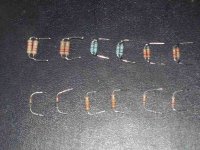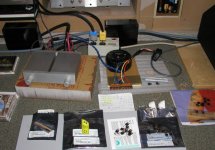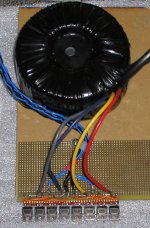Thanks for helping me understand. And thank goes out to JDEV for the power supply schematics. I appreciate it. So I am almost convinced to build one for myself. A couple more questions:
Peter Daniel, what are the Volts & Amps of the hexfred diodes you are using on your power supply with the Plitron (22-0-22 @400VA) power transformer? And where did you order them from. I am looking at digikey but am not sure which ones would be the best to use. If possible an order number would be very helpful.
Next question is, I really do not want a potimeter on these amps. I will be running them with a tube preamp that I have built. So can I just replace the 50K pot with a 50k .5W resistor? Or is there another value that would be better?
Peter thanks for the inspiration, you do great work. And you can use standard aluminum bar stock as heatsink with the LM3875T? That gives alot of creativitivy to enclosure design.
Thanks again everyone
Peter Daniel, what are the Volts & Amps of the hexfred diodes you are using on your power supply with the Plitron (22-0-22 @400VA) power transformer? And where did you order them from. I am looking at digikey but am not sure which ones would be the best to use. If possible an order number would be very helpful.
Next question is, I really do not want a potimeter on these amps. I will be running them with a tube preamp that I have built. So can I just replace the 50K pot with a 50k .5W resistor? Or is there another value that would be better?
Peter thanks for the inspiration, you do great work. And you can use standard aluminum bar stock as heatsink with the LM3875T? That gives alot of creativitivy to enclosure design.
Thanks again everyone
Guiness said:what are the Volts & Amps of the hexfred diodes you are using on your power supply with the Plitron (22-0-22 @400VA) power transformer? And where did you order them from. I am looking at digikey but am not sure which ones would be the best to use. If possible an order number would be very helpful.
I'm just testing today 6 different diode types for discreet bridges. I'll post later today my findings. As to a pot, I think you are correct.
Peter,
I think you should sell a few thousand first,
then be in the position to give one away!
btw, do you have a name for your "company".
Not that i even know if you'll ever come to the point of
making one available for purchase... i was thinking though,
if the Gain Card sells for $3,500 (that's USD) what the
hell will one of yours be worth??? at least $7K
- - more importantly you've inspired me to try putting one
together (i put in a sample request last night!)
m.
I think you should sell a few thousand first,
then be in the position to give one away!
btw, do you have a name for your "company".
Not that i even know if you'll ever come to the point of
making one available for purchase... i was thinking though,
if the Gain Card sells for $3,500 (that's USD) what the
hell will one of yours be worth??? at least $7K

- - more importantly you've inspired me to try putting one
together (i put in a sample request last night!)
m.
So I spent 4 hours today comparing different diodes. This is the choice I used:
MUR1620 (hexfred) $1.66
HFA08TB60 (hexfred) $2.17
8ETH03 (ultrafast) $1.00
15ETH06 (ultrafast) $1.39
MUR820 (schottky) $1.08
MUR1520 (schottky) $1.71
Beside are the prices in CAD for quantity 10 and more. All available from Digi-Key. And here's my test setup.
MUR1620 (hexfred) $1.66
HFA08TB60 (hexfred) $2.17
8ETH03 (ultrafast) $1.00
15ETH06 (ultrafast) $1.39
MUR820 (schottky) $1.08
MUR1520 (schottky) $1.71
Beside are the prices in CAD for quantity 10 and more. All available from Digi-Key. And here's my test setup.
Attachments
This was the first time I really compared dides and I have to admit that in some cases the difference in sound was comparable to placing different capacitors in a circuit. I also noticed that diodes (like resistors) are directional  .
.
I was looking for a natural sound, something that draws my attention and don't allow me to get bored fast. I didn't want the mechanical sound.
The choice wasn't really easy, because all of those diodes are decent quality and supposed to be better then standard rectifiers.
First one to be put aside as least appealing was 15ETH06. Thet's the one I liked the least. The other one that was definitely different from the rest was MUR1520. This diode sounded most natural and grabbing attention. It had very good detail and resolution, probably because it softened highs a bit. Also the voice was very laid back, but sounding very narural, without the glare and harshness that other diodes provided.
I didn't test MUR1620, because being common cathode diode, it didn't fit my circuit.
The 3 other types were pretty close together, with MUR820 close to MUR1520 in character, without softening the trebles so much though. I thought that this might be good substitute for 1520, yet I found it less engaging.
The 8ETH03 was also nice sounding and it was probably the second after 1520 that was drawing my attention to music. The HFA08TB60 being the most expensive of the bunch was also at the end of my list. Actually I couldn't find nothing wrong with it, it seemed to be most neutral, but I thought it was also most mechanical sounding from the group.
So here it is, the quick overview of some of the diodes. It is only the first impression I got and more lengthy listening sessions are in order, but as they say, the first impression is usually correct. Also that choice is probably very dependant on the rest of the system and listening preferences and may vary. My choice for today is MUR1520.
I'm always open for other suggestions and ready to try more. Next thing I will try, is how the umbilical cord from PS to the amp affects the sonics.
I was looking for a natural sound, something that draws my attention and don't allow me to get bored fast. I didn't want the mechanical sound.
The choice wasn't really easy, because all of those diodes are decent quality and supposed to be better then standard rectifiers.
First one to be put aside as least appealing was 15ETH06. Thet's the one I liked the least. The other one that was definitely different from the rest was MUR1520. This diode sounded most natural and grabbing attention. It had very good detail and resolution, probably because it softened highs a bit. Also the voice was very laid back, but sounding very narural, without the glare and harshness that other diodes provided.
I didn't test MUR1620, because being common cathode diode, it didn't fit my circuit.
The 3 other types were pretty close together, with MUR820 close to MUR1520 in character, without softening the trebles so much though. I thought that this might be good substitute for 1520, yet I found it less engaging.
The 8ETH03 was also nice sounding and it was probably the second after 1520 that was drawing my attention to music. The HFA08TB60 being the most expensive of the bunch was also at the end of my list. Actually I couldn't find nothing wrong with it, it seemed to be most neutral, but I thought it was also most mechanical sounding from the group.
So here it is, the quick overview of some of the diodes. It is only the first impression I got and more lengthy listening sessions are in order, but as they say, the first impression is usually correct. Also that choice is probably very dependant on the rest of the system and listening preferences and may vary. My choice for today is MUR1520.
I'm always open for other suggestions and ready to try more. Next thing I will try, is how the umbilical cord from PS to the amp affects the sonics.
Attachments
Peter Daniel said:diode testing....
You should try some of those Fairchild Semi Ultrasoft, Hyperfast ones, and see how they compare.
--
Brian
Yesterday when replacing OPA549 with LM3875 , I accidentally caused a short between V- and pin 8 , Input, on LM3875 - without noticing. When I switched on the amp the 1 channel was causing alot of high frequency sound and other channel was dead. I started to test and soon find problem, this short, and also that this side's speaker was now measuring only 1ohm, oops!  Luckilly the amp was connected to a set of cheap speakers of which I got 6 from a guy that chukked them away. BTW, I can actually start noticing differance between 2 IC's, LM 3875 sound much more likeable - and to close for comfort to my Aleph30
Luckilly the amp was connected to a set of cheap speakers of which I got 6 from a guy that chukked them away. BTW, I can actually start noticing differance between 2 IC's, LM 3875 sound much more likeable - and to close for comfort to my Aleph30 
1.)Could this short between V- and In caused the speaker to pop?
2.) Can 1 protect your speakers against such faults without causing any degrading in sound quality?
 Luckilly the amp was connected to a set of cheap speakers of which I got 6 from a guy that chukked them away. BTW, I can actually start noticing differance between 2 IC's, LM 3875 sound much more likeable - and to close for comfort to my Aleph30
Luckilly the amp was connected to a set of cheap speakers of which I got 6 from a guy that chukked them away. BTW, I can actually start noticing differance between 2 IC's, LM 3875 sound much more likeable - and to close for comfort to my Aleph30 
1.)Could this short between V- and In caused the speaker to pop?
2.) Can 1 protect your speakers against such faults without causing any degrading in sound quality?
Peter Daniel said:If you supply around 25V DC to the speaker, you shouldn't be surprised that it pops.
Sorry , the short was between pin 8 and V-, I editted origenal post.
JDev,
1) Yes, 18-24VDC directly to your speakers is bad.
2) Yes, don't short your legs That and there are other circuits you can add in that protect your speakers but they are actually larger than the entire gainclone circuit. One is a "crowbar" circuit. Consisting of a diac, a triac, a Zobel circuit, a few diodes across the power rails, an RC circuit and a shunt cap across the speaker leads . It also adds an inductor in the path. My suggestion is just to keep your path as short as possible without shorts
That and there are other circuits you can add in that protect your speakers but they are actually larger than the entire gainclone circuit. One is a "crowbar" circuit. Consisting of a diac, a triac, a Zobel circuit, a few diodes across the power rails, an RC circuit and a shunt cap across the speaker leads . It also adds an inductor in the path. My suggestion is just to keep your path as short as possible without shorts 
Once you close up your final assembly they are so cheap you can build a prototype to mess around with and not worry about losing some music time.
1) Yes, 18-24VDC directly to your speakers is bad.

2) Yes, don't short your legs
Once you close up your final assembly they are so cheap you can build a prototype to mess around with and not worry about losing some music time.
Hi Peter!
Are you sure the Motorola MUR1520 is a schottky?
Not according the data sheet of the series MUR1520-1540-1560 where these diodes are simply Ultrafast Rectiers (not even soft recovery, just ultrafast).
I spent nearly a fortune to order some expensive IR Hextfred at Digi Key, while I have plenty of MUR1520.........
I'm glad you liked them in the gainklone anyway: at least if I'll make it I already have some suitable components.
Are you sure the Motorola MUR1520 is a schottky?
Not according the data sheet of the series MUR1520-1540-1560 where these diodes are simply Ultrafast Rectiers (not even soft recovery, just ultrafast).
I spent nearly a fortune to order some expensive IR Hextfred at Digi Key, while I have plenty of MUR1520.........
I'm glad you liked them in the gainklone anyway: at least if I'll make it I already have some suitable components.
Peter: I bought parts for my gainclone yesterday, the shop hadn't 3875 nor 3885, so I use two TDA7296
Now, I've seen your shematic, and I just realised you suggest 1W 10kR and 1/2W 220kR resistors, but I use classical 1/4W metal film ones
Is this a problem? I don't see the use for such powerfull resistors, can you please explain why you use those?
Now, I've seen your shematic, and I just realised you suggest 1W 10kR and 1/2W 220kR resistors, but I use classical 1/4W metal film ones
Is this a problem? I don't see the use for such powerfull resistors, can you please explain why you use those?
massimo said:Hi Peter!
Are you sure the Motorola MUR1520 is a schottky?
Not according the data sheet of the series MUR1520-1540-1560 where these diodes are simply Ultrafast Rectiers (not even soft recovery, just ultrafast).
I also thought it's a ultrafast diode, but in Digi-Key katalog it's listed under schottky http://dkc3.digikey.com/PDF/C031/0511.pdf
unless I got it wrong (top left). The one I'm using is from IR.
Bricolo said:
Now, I've seen your shematic, and I just realised you suggest 1W 10kR and 1/2W 220kR resistors, but I use classical 1/4W metal film ones
Is this a problem? I don't see the use for such powerfull resistors, can you please explain why you use those?
Nothing wrong with different parts. It's just that I used the listed ones and they make the amp sound really well.
Hi Peter,
Thanks a lot for sharing your findings on the differences in diodes, which make interesting reading.
This list of preferences will be most useful for many DIYers who maybe don't have the chance to make these comparisons.
I did a lot of similar listening tests maybe 10 years ago, and I came down heavily in favour of Shottkys then, but there have been a lot of developments/improvements in diodes' specs since that time.
Like you, I found them all to be very directional!
You will doubtless get a lot of "try this and try that" now you have published your results, but if you do get the chance, it might be worth having a listen to some of the Ixys HiPerFRED diodes, DSEP 9-06CR.
Todd Krieger said some glowing things about them on AA in Nov. 2001, when he compared these with both Hexfreds and Harris Ultrafasts, but I still have been unable to find anyone who I regularly deal with who will let me have a few to try.
I'll still keep on looking, though.
I hope the GC business is taking off well.
Regards,
Thanks a lot for sharing your findings on the differences in diodes, which make interesting reading.
This list of preferences will be most useful for many DIYers who maybe don't have the chance to make these comparisons.
I did a lot of similar listening tests maybe 10 years ago, and I came down heavily in favour of Shottkys then, but there have been a lot of developments/improvements in diodes' specs since that time.
Like you, I found them all to be very directional!

You will doubtless get a lot of "try this and try that" now you have published your results, but if you do get the chance, it might be worth having a listen to some of the Ixys HiPerFRED diodes, DSEP 9-06CR.
Todd Krieger said some glowing things about them on AA in Nov. 2001, when he compared these with both Hexfreds and Harris Ultrafasts, but I still have been unable to find anyone who I regularly deal with who will let me have a few to try.
I'll still keep on looking, though.

I hope the GC business is taking off well.
Regards,
- Status
- This old topic is closed. If you want to reopen this topic, contact a moderator using the "Report Post" button.
- Home
- Amplifiers
- Chip Amps
- This is not just another gainclone


